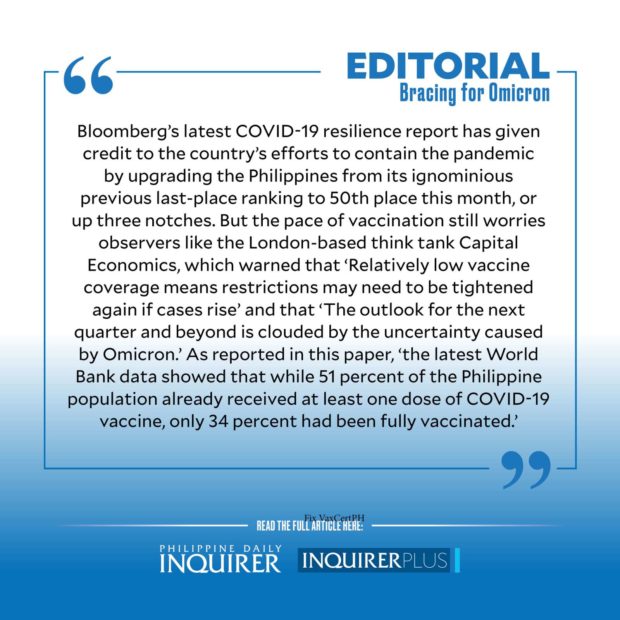Bracing for Omicron
And just like that, countries and borders and establishments are shutting down once again in many parts of the world as cases of the new COVID-19 variant Omicron surge across populations. Europe and the US, which had relaxed most pandemic restrictions following a vast head start in mass-vaccinating their citizens, are now back to using grim, cataclysmic language to describe the threat of Omicron: Both Washington and London have warned about a “tidal wave” of new cases arising from the fleet-footed variant.
Last week, per a Reuters count, cases in the US were up by 40 percent and COVID-19 hospitalization by 45 percent; in the UK as of Dec. 23, new cases were at 122,186 — a new record, and the third day the numbers had breached 100,000. Much of the rest of the world has reverted to by-now-familiar defensive mode, curtailing mobility and delaying border reopenings; as the Agence France-Presse reported, “for the second year, surging infections have complicated yuletide plans from Sydney to Seville.”
Article continues after this advertisementThe consolation is that, according to two recent UK studies, the Omicron variant appears to be less deadly compared to its predecessor Delta in terms of sending people to the hospital; the illness it engenders is generally milder, with the risk of hospital stay about 40 to 45 percent lower. The other side of the coin, however, is that Omicron is turning out to be more infectious and may afflict many more people in a shorter period of time, thus the specter of hospitals once again getting overwhelmed and health services compromised, leading to more deaths.
The World Health Organization’s recommendations for countries to contain the Omicron variant are straightforward: “Countries should continue to implement the effective public health measures to reduce COVID-19 circulation overall, using a risk analysis and science-based approach. They should increase some public health and medical capacities to manage an increase in cases … In addition, it is vitally important that inequities in access to COVID-19 vaccines are urgently addressed to ensure that vulnerable groups everywhere, including health workers and older persons, receive their first and second doses, alongside equitable access to treatment and diagnostics.”
In other words, continued safety precautions, the shoring up of health care systems, and ramped-up vaccinations. How is the Philippines doing in this regard, now that the country has announced that the Omicron variant is here, and—if its recent history with the Delta strain is any gauge—the country is likely to see a rise in cases by January 2022 after the holiday festivities, as projected by independent research group OCTA?
Bloomberg’s latest COVID-19 resilience report has given credit to the country’s efforts to contain the pandemic by upgrading the Philippines from its ignominious previous last-place ranking to 50th place this month, or up three notches. But the pace of vaccination still worries observers like the London-based think tank Capital Economics, which warned that “Relatively low vaccine coverage means restrictions may need to be tightened again if cases rise” and that “The outlook for the next quarter and beyond is clouded by the uncertainty caused by Omicron.” As reported in this paper, “the latest World Bank data showed that while 51 percent of the Philippine population already received at least one dose of COVID-19 vaccine, only 34 percent had been fully vaccinated.” The Philippines’ neighbors have comparatively higher vaccination figures: Cambodia 80 percent, Malaysia 78 percent, Thailand 61 percent, Vietnam 55 percent, Indonesia 37 percent. Only Myanmar is lower than the Philippines at 22 percent.
While the vaccination coverage has now been expanded to include minors, as well as booster shots for those already fully jabbed, in some ways the government remains seemingly fixated on peculiar, unsound measures it had needlessly staked time, energy, and resources on in the past two years. President Duterte, for example, continues to tout the efficacy of long-discredited face shields; in recent remarks, he batted for the return of the despised device in case of an Omicron surge—despite the scant science behind it that he himself acknowledged (“I cannot quantify or by what percentage, it’s just a gut feeling…”), and despite face shields having become a sordid symbol of the sprawling corruption and mendacity that appear to have accompanied the government’s pandemic response as revealed by the Pharmally scandal.
As for fortifying the health system against Omicron and other future hazards? Until now, PhilHealth is bogged down in talks with a growing number of hospitals that have threatened to disengage from the national health insurer over outrageously delayed payments running into the billions. New COVID-19 variant or not, some things seem bound to stay the same in these parts.

















